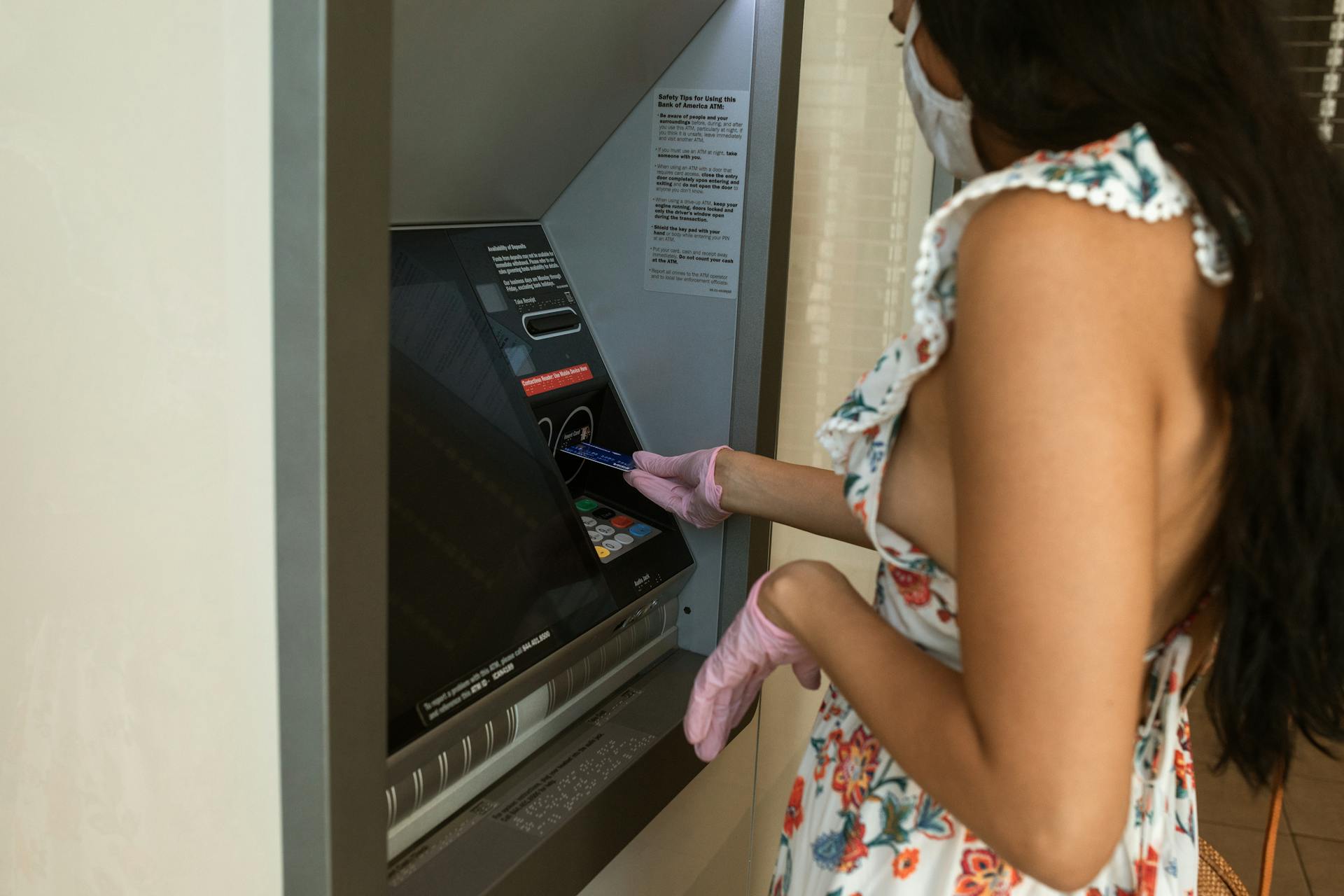
A good cash conversion cycle is a key indicator of a company's liquidity and financial health. It's the time it takes for a company to sell its inventory, collect on its accounts receivable, and pay its accounts payable.
The ideal cash conversion cycle varies by industry, but a general rule of thumb is to aim for a cycle that's less than 30 days. This allows companies to maintain a healthy cash flow and stay ahead of their competition.
In the retail industry, for example, a cash conversion cycle of 10-15 days is considered good. This is because retailers typically have a high volume of inventory and need to quickly turn it over to stay competitive.
See what others are reading: Average Cash Conversion Cycle by Industry
What is Cash Conversion Cycle
The Cash Conversion Cycle (CCC) is a metric that measures how well a company uses its working capital. It's a key indicator of a company's liquidity and efficiency in managing its day-to-day operations.
The CCC combines several activity ratios, including outstanding inventory, accounts receivable, and accounts payable. This means that to calculate the CCC, you need to consider the average inventory over a period, cost of goods sold or cost of sales, accounts receivable balance, annual revenue, and ending accounts payable.
The CCC uses the average times to pay suppliers, create inventory, sell products, and collect customer payments. The shorter this timeframe is, the better it is for the company.
To give you a better idea, here are the components of the CCC calculation:
- Average inventory over the period
- Cost of goods sold or cost of sales
- Accounts receivable balance
- Annual revenue
- Ending accounts payable
These components help you calculate days of inventory outstanding, days of sales outstanding, and days of payables outstanding.
Inventory Management
A good cash conversion cycle is all about how efficiently a business can turn its inventory into sales. This is where inventory management comes in, and one key metric to focus on is Days Inventory Outstanding, or DIO.
A lower DIO indicates that a company is making sales rapidly with better turnover. This is calculated by dividing the average inventory by the cost of goods sold, then multiplying by 365 days.
The formula for DIO is DIO = Average Inventory / COGS x 365 Days. To calculate the average inventory, you need to know the beginning and ending inventory, which can be added together and divided by two.
For example, if a company has a beginning inventory of $1,000 and an ending inventory of $3,000, the average inventory would be $2,000. This is calculated by taking the average of the two, or 0.5 x ($1,000 + $3,000).
A higher inventory turnover, or quicker sales, decreases the cash conversion cycle. This is a positive for the cash conversion cycle and a company's overall efficiency.
It takes Company A approximately 18 days to turn its inventory into sales. This is calculated using the DIO formula and the company's cost of goods sold. The smaller the number, the better, indicating that the company is selling its inventory quickly.
Recommended read: How to Get Two Hundred Dollars Fast
Sales and Payable
A lower Days Sales Outstanding (DSO) value indicates that a company can collect capital in a short time, enhancing its cash position.
DSO is calculated by dividing average accounts receivable by revenue per day, using the formula DSO = Average Accounts Receivable / Revenue Per Day. Average Accounts Receivable is calculated as 0.5 x (BAR + EAR).
A higher Days Payable Outstanding (DPO) value means a company holds onto cash longer, increasing its investment potential. DPO is calculated by dividing average accounts payable by COGS per day, using the formula DPO = Average Accounts Payable / COGS Per Day. Average Accounts Payable is calculated as 0.5 x (BAP + EAP).
A longer DPO is better, as it allows a company to hold onto cash longer, maximizing its investment potential.
Worth a look: Venmo 5 Cash Back
Sales (SO)
Sales (SO) is a critical aspect of a company's financial health. A lower Sales (SO) value indicates that a company can collect cash from its sales in a short time, enhancing its cash position.
The formula for calculating Sales (SO) is not explicitly mentioned in the article, but we can infer that it's related to the calculation of Days Sales Outstanding (DSO). DSO is the number of days it takes a company to collect its receivables, which is calculated by dividing average accounts receivable by revenue per day.
A company with a lower DSO value is more likely to have a better cash position, as it can collect cash from its sales in a shorter period. For example, if a company has an average accounts receivable of $3,000 and credit sales of $100,000, its revenue per day would be $100,000 / 365 = $274.
To calculate DSO, you need to know the average accounts receivable and revenue per day. Average accounts receivable can be calculated by taking the average of beginning and ending accounts receivable.
Payable (PO)
Payable (PO) is a crucial aspect of a company's financial health. It measures the average number of days it takes to pay back its payables, also known as accounts payable. This metric reflects the company's payment of its own bills or accounts payable (AP).
A longer DPO, or days payable outstanding, is better as it allows the company to hold onto cash longer, maximizing its investment potential. This can be achieved by improving trade credit terms with vendors.
Vendors often look at a company's CCC, or cash conversion cycle, when deciding whether to offer trade credit. A lower CCC indicates that a company has healthy liquidity and is more likely to pay its bills on time. This can improve a company's chances of getting better credit terms from vendors.
The formula for DPO is DPO = Average Accounts Payable / COGS Per Day. Average Accounts Payable can be calculated using the formula 0.5 x (BAP + EAP).
Calculating CCC
Calculating CCC is a straightforward process that involves tracking three working capital metrics: Days Inventory Outstanding (DIO), Days Sales Outstanding (DSO), and Days Payable Outstanding (DPO).
To calculate DIO, you need to divide the average inventory by the cost of goods sold and multiply it by the number of days. This metric measures how quickly a company can sell its inventory.
DSO, on the other hand, is calculated by dividing accounts receivable by total credit sales and multiplying it by the number of days. This metric evaluates how quickly a company can collect payment from customers.
DPO is calculated by dividing accounts payable by the cost of goods sold and multiplying it by the number of days. This metric assesses how long a company takes to pay its suppliers.
The formula for calculating the cash conversion cycle (CCC) is CCC = DIO + DSO - DPO.
Here's a summary of the three working capital metrics:
By consistently monitoring these metrics, a company can identify and improve operational deficiencies related to working capital that reduce free cash flows and liquidity.
Analyzing and Improving CCC
Analyzing the cash conversion cycle (CCC) involves evaluating the efficiency of a company's operations and management. The CCC formula assesses how quickly a company can convert investments in production and sales into cash or working capital.
To analyze the CCC, you should track it over multiple quarters to see if it's improving, maintaining, or worsening its operational efficiency. This will help you identify areas that require improvement and implement necessary adjustments.
A lower CCC is considered a good cash conversion cycle, but the target number of days varies by industry. For instance, retailers typically have a shorter CCC than manufacturers due to their faster inventory turnover rate.
Improving the CCC requires a holistic approach that involves optimizing the entire supply chain, from purchasing and production to sales and collections. This can be achieved by automating processes, providing real-time data and analytics, and enabling businesses to make more informed decisions.
A negative cash conversion cycle is desirable, as it means the company can collect payment from customers before it has to pay its suppliers. However, negative CCCs are rare and may not be sustainable in the long term.
Here are some key takeaways to consider when analyzing and improving the CCC:
- The cash conversion cycle represents the duration required by a company to convert investments in production and sales into cash or working capital.
- A shorter cash conversion cycle leads to healthier cash flow, allowing the company to meet financial obligations promptly without incurring penalties.
- Improving CCC requires a holistic approach that involves optimizing the entire supply chain, from purchasing and production to sales and collections.
- Technology can play a key role in improving CCC by automating processes, providing real-time data and analytics, and enabling businesses to make more informed decisions.
By tracking the CCC over time and implementing necessary improvements, businesses can achieve a healthier cash flow and meet their financial obligations promptly.
Example and Case Studies
Let's take a look at some examples to understand what a good cash conversion cycle is.
A company called ABC Inc. in the bicycle manufacturing industry had a cash conversion cycle of 70.56 days, which was calculated using the formula: CCC = DIO + DSO - DPO.
The company's DIO was 60.83 days, DSO was 58.4 days, and DPO was 48.67 days.
This means that on average, it took ABC Inc. 60.83 days to sell its inventory, 58.4 days to collect its accounts receivable, and 48.67 days to pay its accounts payable.
Another example is Company X, a retailer with a cash conversion cycle of 83 days.
The company's DIO was 182.5 days, DSO was 3.9 days, and DPO was 103.4 days.
Here's a comparison of the two companies' cash conversion cycles:
Note that Company X had a significantly longer DIO than ABC Inc., which contributed to its longer cash conversion cycle.
Special Considerations
The Cash Conversion Cycle (CCC) is a valuable tool for evaluating performance, especially when calculated over several consecutive periods and compared to competitors. A decreasing or steady CCC is a positive indicator.
CCC can also be applied to non-traditional businesses like consulting firms and software companies. You'll get a negative result similar to an online retailer because you omit days of inventory outstanding.
Rising CCCs require a closer look to understand the underlying issues.
Frequently Asked Questions
Is it better for the CCC to be positive or negative?
A negative cash conversion cycle is generally more desirable, as it indicates your business can quickly convert cash and maintain liquidity. This allows for more cash on hand to cover expenses and invest in growth.
Sources
- https://www.investopedia.com/terms/c/cashconversioncycle.asp
- https://www.wallstreetprep.com/knowledge/cash-conversion-cycle-ccc/
- https://corporatefinanceinstitute.com/resources/accounting/cash-conversion-cycle/
- https://www.highradius.com/resources/Blog/what-is-cash-conversion-cycle/
- https://www.investopedia.com/articles/06/cashconversioncycle.asp
Featured Images: pexels.com


